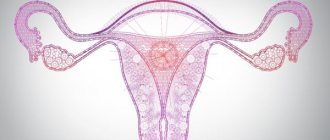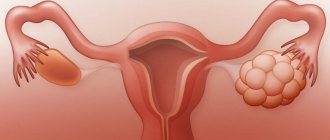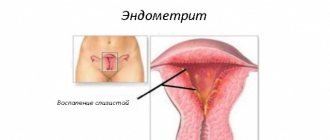Hormonal contraceptives are used by many modern girls to protect themselves from unwanted pregnancy, as well as in the treatment of infertility. However, the time comes when they need to be canceled. And in order to do this correctly, with the least possible complications, it is worth knowing the recommendations of doctors. Read more in our article about the abolition of hormonal contraceptives and possible side effects after.
Symptoms and signs
The clinical picture of coke withdrawal syndrome is accompanied by the following manifestations:
- Menstrual irregularities or absence of menstruation. Such changes are associated with irregular periods before starting to take medications or loss of communication between the ovaries and hypothalamus while taking contraceptives.
- Heavy bleeding.
- Intense pain during menstruation, especially if PMS, menstruation were painful before.
- Pain that occurs during ovulation. When using tablets, it is suppressed, and therefore the woman does not experience any discomfort.
- The appearance of acne. This is explained by the fact that the tablets suppress the production of the hormone testosterone, which is responsible for the formation of acne. After their cancellation, acne appears again.
- Fluid retention, the appearance of minor edema. Some drugs contain components that have a diuretic effect, so after their withdrawal a feeling of fullness appears.
- Unmotivated, unpredictable mood swings. An increased level of irritability and moodiness may appear.
- Lack of nutrients. Against this background, there is a decrease in fertility, problems with fertilization, and pregnancy.
In addition, pathological symptoms such as:
- amenorrhea;
- infertility;
- polycystic ovary syndrome;
- hypothyroidism;
- rosacea;
- feeling of headache;
- deterioration of hair condition, hair loss;
- decrease or increase in the amount of glucose in the blood;
- depressed mood;
- increased level of anxiety;
- flatulence;
- liver dysfunction;
- intestinal dysbiosis;
- inflammatory processes;
- immune disorders.
Often the listed side symptoms of contraceptive withdrawal do not disappear on their own; they need to be corrected by using other medications. This entire process must be supervised by a doctor.
Restoration of menstruation
In order to return to the previous volume of menstrual blood loss, an increase in the thickness of the endometrium is necessary.
The speed of this process depends on:
- duration of use and type of birth control pills;
- initial hormonal background;
- age;
- diseases of the ovaries, uterus and general health.
The recovery period is different for everyone, and it is impossible to predict its duration in advance. Since fluctuations in hormone levels are observed at this time, pregnancy is not recommended until the cycle is completely normalized. Its course can be complicated.
To stabilize the cycle, vitamins are taken in a cyclic manner: vitamin A, folic and glutamic acids in the first half, and E and C in the second. The doctor can also prescribe phytoestrogens - red clover, soy, black cohosh - in the estrogenic phase, and chasteberry, boron uterus, wild yam - in the progesterone phase. Even these natural remedies need to be used after examination.
What to do, how to alleviate and get rid of
The use of drugs does not eliminate serious dysfunctions of the endocrine system; they only temporarily mask their symptoms. There is a suppression of hormone production, ovulation, and the menstrual cycle is disrupted.
Quite often the concentration of those hormones that were normal before taking the drugs changes. As a result, the woman is prescribed other medications aimed at combating these symptoms caused by long-term use of COCs.
Natural remedies can help overcome pathological symptoms, but this may take more time.
Recommended:
- Review and adjust your diet in such a way as to replenish your supply of nutrients. It is worth eating as many vegetables, fruits, berries, and foods containing large amounts of animal proteins as possible. You can start taking vitamin-mineral complexes, but before doing this you need to consult a doctor and undergo all the necessary examinations.
- Normalize blood sugar levels. This nuance is considered especially important for women who are susceptible to hormonal disorders and diabetes. It is recommended not to skip breakfast, to minimize the consumption of sugar, baked goods, and alcohol. Physical activity will be useful, but it must be dosed.
- Control the amount of milk consumed; it must be natural. Consumption of excessive amounts of dairy products provokes an increase in insulin, which is dangerous for the development of polycystic ovary syndrome and hormonal disorders.
- Fight against etrogen dominance.
- Drink pro- and prebiotics, lactobacilli, bifidobacteria, eat foods containing fiber.
- Avoid taking antibacterial drugs.
- Detoxify the body.
- Monitor the condition of the liver, because it is this organ that is subjected to double load while taking medications and is responsible for processing used hormones and removing their breakdown products.
The result will be positive if you take plant extracts, dietary supplements, and vitamins.
What are hormonal contraceptives?
Hormonal drugs to prevent unwanted pregnancy contain estrogen and progestin. Each manufacturer uses a special combination of these substances, which allows each woman to choose the product that best suits her. The hormones contained in OCs are very similar in structure and properties to those produced by the ovaries. That is why they have many positive properties.
The contraceptive effect of these drugs is ensured in the following way:
- the process of maturation and release of the egg is suppressed. In women taking these drugs, ovulation does not occur at all;
- the mucous membrane of the uterus changes in such a way that the attachment of a fertilized egg is simply impossible;
- the mucus in the cervix thickens significantly, which will become an obstacle to the penetration of sperm;
- certain changes also occur in the fallopian tubes. As a result, sperm are unable to move there normally.
Sweet and flour - what are the consequences of replacing coke
The main feature of bakery products and sweets is that these products are very tasty. Even those people who may refuse to eat them, but do so from time to time, claim that they really like the taste of sweets.
It is also necessary to focus on the fact that they also bring a lot of benefits:
- serve as a source of energy, because they contain carbohydrates, they quickly nourish the body and brain;
- help in the psychological aspect, elevate mood, which is important when dealing with coke withdrawal syndrome;
- chocolate contains a lot of iron, magnesium, antioxidants;
- dried fruits are rich in pectins, microelements, which are endowed with the ability to improve the digestion process and intestinal functioning
- gelatin, which is included in sweets, is endowed with the ability to improve hair structure, skin condition, and is beneficial for muscle fibers.
Taking into account the listed factors, we can say with confidence that sweets are not so harmful. Therefore, you should not refuse to use them. It is recommended to control the amount of sweets so that they do not lead to health problems or cause re-addiction.
A woman who has a disease and refuses to take coke may again experience the fact that her ovaries will fail and the pathological symptoms of the disease will return.
How does a woman’s body recover after stopping birth control pills?
After discontinuation of hormonal contraceptives, a woman’s reproductive system undergoes certain changes, which leads to the restoration of its functioning:
- The processes that occur during the secretory phase of the menstrual cycle are restored.
- The first atrophic changes begin in the endometrium (inner layer of the uterus).
- The ability of the uterus to provide optimal conditions for implantation and fetal development is restored.
- The vaginal microflora also undergoes changes.
- The viscosity of cervical mucus decreases. This leads to the fact that sperm can freely penetrate the uterus and fertilize the egg.
General description of the syndrome
Withdrawal syndrome is manifested by a deterioration in a person’s well-being. The body reacts by stopping the substance or reducing the dose of the drug that caused the addiction. The intensity of pathological manifestations depends on the properties and composition of the drugs.
To combat this condition, infusion therapy is used; the use of isotonic sodium chloride solution, glucose, diuretics, and specific antidotes is considered justified.
Withdrawal syndrome is the body's reaction when a person stops using drugs, tobacco, alcohol, or any addictive habit. One must avoid this because it can be fatal and must be treated on time.
The withdrawal symptom complex is an indicator of physical dependence formed against the background. The symptoms that make it up can be divided into: central and peripheral. This syndrome is also called withdrawal. More often it is formed due to alcohol, nicotine, drug and other addictions.
A high risk of developing manifestations of the withdrawal symptom complex is present when taking drugs that are endowed with the ability to be quickly eliminated from the body cavity, with prolonged use and abrupt cessation of their use.
The course is considered severe in children, elderly people and patients with a history of chronic diseases, or if they are in an acute form of the course.
A provoking factor of addiction - substances can influence biochemical processes, the functioning of the nervous system, endocrine glands and internal organs.
They are used to treat diseases, but over time they become addictive. Sudden withdrawal of a substance is accompanied by the inability of biological systems to restore their functioning.
Withdrawal is classified depending on the substance that provoked it; to carry out adequate therapy and determine further tactics, the syndrome is distinguished:
- Regenerative. A mild form of the disease, in which the body is able to fully recover without outside help.
- Stable. Its course is easy to predict and can be easily corrected through medication.
- Intermittent. Characterized by alternating changes of exacerbation and improvement. With adequate therapy, the prognosis is favorable.
- Degenerative. It has an unfavorable course and requires hospital treatment. There is a high risk of relapse.
Manifestations of the withdrawal symptom complex, the intensity of its symptoms depend on the substance that was used, its dose, and the duration of therapy.
The provoking factor of development is the systematic use of any surfactants, for example, alcohol, nicotine, opioids, cannabinoids, cocaine, and a number of drugs. The intensity of pathological manifestations and the brightness of the clinical picture will depend on the rate of elimination of the substance from the body.
Manifestations of withdrawal syndrome are different, it all depends on the type of surfactant. Common clinical manifestations include depressive disorders, sleep problems, and increased levels of anxiety.
The syndrome can be mild, moderate or severe.
Mild degree manifests itself:
- insomnia;
- excessive excitability;
- increased level of irritability;
- anxiety;
- disruption of the digestive tract, which manifests itself as nausea and abdominal pain.
A moderately severe syndrome is characterized by the addition of such pathological manifestations as:
- trembling of limbs;
- increased level of sweating;
- cardiopalmus;
- increased blood pressure;
- unbearable nausea;
- vomit;
- diarrhea.
Abstinence in severe form is accompanied by the appearance of such manifestations as:
- increased body temperature;
- excessive excitability, which is accompanied by visual and tactile hallucinations, delusions;
- disturbances of consciousness.
Convulsive seizures may occur. Typically, the consequences of abrupt withdrawal of an addictive substance begin to appear 4-24 hours after stopping the use of the surfactant.
Symptoms reach their highest peak after 36-48 hours. However, these terms are arbitrary; for example, nicotine withdrawal syndrome can appear within an hour after the last cigarette smoked.
Stopping GCS is accompanied by a feeling of weakness, general malaise, and loss of appetite. In rare cases, nausea, vomiting, seizures, and the development of collapse are diagnosed.
Abrupt cessation of taking antianginal drugs for coronary heart disease increases the risk of angina attacks, increased blood pressure, and the development of pathological reactions to physical stress.
Withdrawal of barbiturates leads to anxiety, tremors, arrhythmia, problems falling asleep and staying asleep, irritability, and increased body temperature. In complicated cases, the development of psychosis with hallucinations is observed.
Withdrawal from opiates provokes the appearance of a runny nose, “goose bumps”, pupils dilate, pain in the muscle fibers and bones, shortness of breath, and anger appear.
Alcohol withdrawal is accompanied by a feeling of general fatigue, weakness, dry mouth, and hyperhidrosis.
Over time, pathological symptoms such as:
- skin hyperemia;
- sudden changes in pressure;
- headache;
- feeling of nausea;
- vomit;
- disorders of consciousness;
- tremor;
- gait disturbance.
There may be an increase in nightmares, the appearance of a depressive mood, and manifestations of aggression.
Doctors of various specialties and areas can diagnose withdrawal syndrome. It is necessary to collect anamnestic data, assess the patient’s general condition, pathological symptoms, and conduct a physical and neurological examination.
If necessary, additional examinations are prescribed, namely:
- ECG;
- Ultrasound of the liver, kidneys;
- general and biochemical blood test;
- OAM;
- blood test for the presence of narcotic substances.
What to do if you need to stop using contraceptives?
According to the recommendations of all gynecologists and manufacturers of hormonal drugs, they should be discontinued after the pack has been completely consumed. Only in this case can you avoid hormonal imbalance, which is sure to happen otherwise. After taking the last tablet from the pack, menstrual-like bleeding begins.
It is also called a withdrawal reaction. Typically, such menstruation begins 1-2 days after finishing taking the pills. To make this process go as smoothly as possible, you must adhere to the following recommendations:
- Before stopping oral contraceptives, you should definitely consult with your gynecologist. In some cases, stopping these medications is strictly prohibited.
- It is recommended to undergo tests to determine the level of sex hormones.
- If possible, you should drink the entire pack to the end. Interrupting the use of oral contraceptives in the middle of the cycle leads to serious consequences for the body. In this case, the woman’s reproductive system will experience enormous stress and react with intense uterine bleeding.
Reasons for formation
The reasons for the formation of abstinence are:
- Reduce dosage. As a result of the intake of a reduced amount of the active substance into the body, abstinence occurs.
- Failure to comply with recommendations regarding intervals between doses. Pathological manifestations of withdrawal may appear when there is a long gap between the next dose of the drug. Often, deterioration in health is observed in the morning before taking the medicine. This feature is usually called the zero hour phenomenon.
- Rapid removal of the active substance from the body. The risk of developing withdrawal increases with the use of drugs with a short therapeutic effect, as well as with diarrhea, vomiting and renal failure. The phenomenon is commonly called rebound syndrome.
- Sudden cessation of taking a substance. It can be triggered by cessation of entry into the body due to unauthorized refusal to take the drug, the inability to do so, or when the patient forgets about the need for use. Pathological symptoms are especially pronounced if the patient took, for example, the drug in fairly high doses.
What other beneficial properties of hormonal contraceptives exist?
By taking hormonal contraceptive drugs, every woman can experience beneficial changes in her body:
- very often, periods become less painful, their duration and the amount of discharge may change to a lesser extent;
- your period always comes on time if you follow the recommendations for taking pills;
- due to inhibition of ovulation, the woman is protected from ectopic pregnancy, which can lead to death;
- the likelihood of developing ovarian and uterine cancer is reduced;
- the chance of a successful pregnancy after stopping the medication is significantly increased;
- the likelihood of developing many inflammatory diseases in the pelvic organs is reduced;
- the risk of osteoporosis decreases;
- the natural defense of the woman’s body is increased, since pathogens are not very often able to penetrate through the viscous cervical mucus;
- the number of rashes on the body that were of a hormonal nature decreases.
Planning pregnancy after stopping oral contraceptives
After discontinuation of hormonal contraceptive drugs, many women begin to plan a pregnancy. Doctors recommend postponing this for about 2-3 months. This term is associated with the fact that a woman’s reproductive system needs time to fully restore its functioning. While taking oral contraceptives, the ovaries were in a so-called sleep state. Therefore, after discontinuation of these drugs, they do not begin to function immediately.
However, we should not forget that pregnancy can occur earlier. Despite this, it may not develop properly. Also, such a pregnancy often ends in spontaneous abortion in the early stages. This is due to the existing hormonal imbalance in the woman’s body. Therefore, it is better to postpone planning a pregnancy for several months, which will guarantee the absence of dangerous complications associated with taking OCs.
Do I need a break during long-term use of hormonal drugs?
Many women, when taking oral contraceptives, worry whether their use over a long period will be harmful. This is due to the fact that previously many manufacturers of hormonal contraceptives recommended taking a mandatory break every 2 years. For 2-3 months, the body needed to be given a break to restore the functioning of the gonads. This was not always convenient, since during this period there was a need to use barrier methods of contraception.
At the moment, many drugs are produced that do not have such restrictions. They can be taken continuously for 35 years. They contain small doses of hormones, which makes it possible not to adhere to this rule. Many doctors do not recommend stopping taking such OCs and then restarting them again after a few months. This will create additional stress for the body and put unnecessary strain on the endocrine system.










